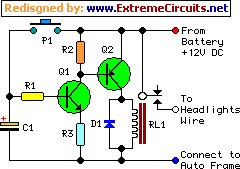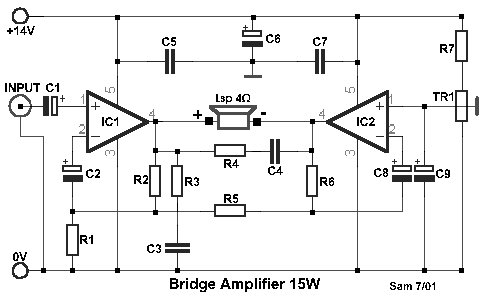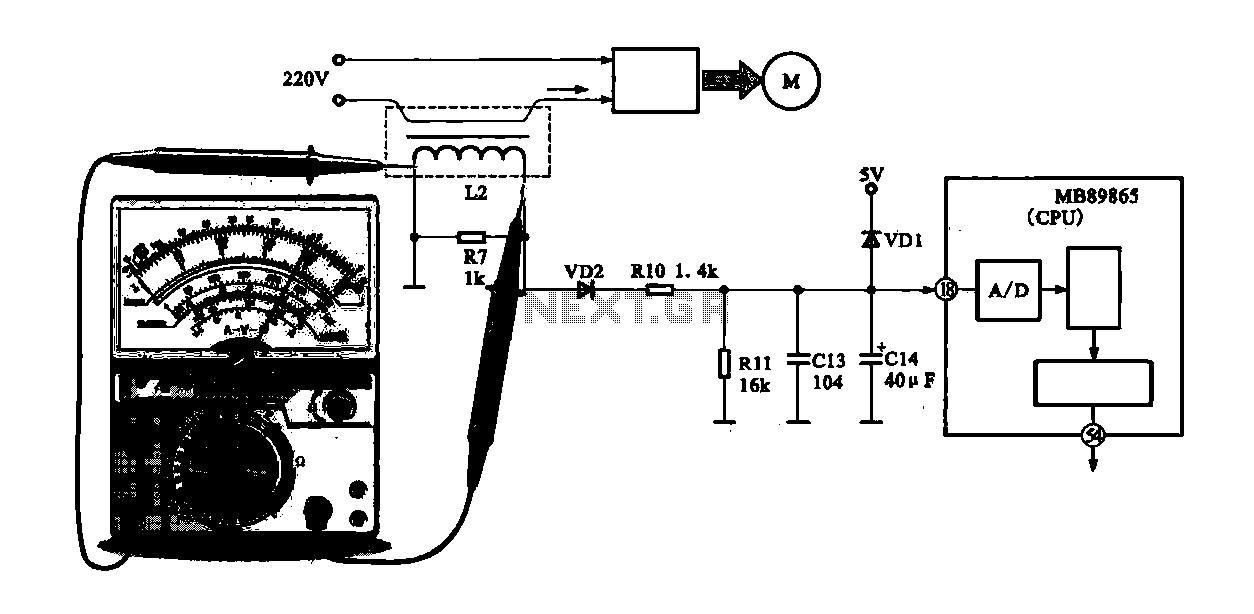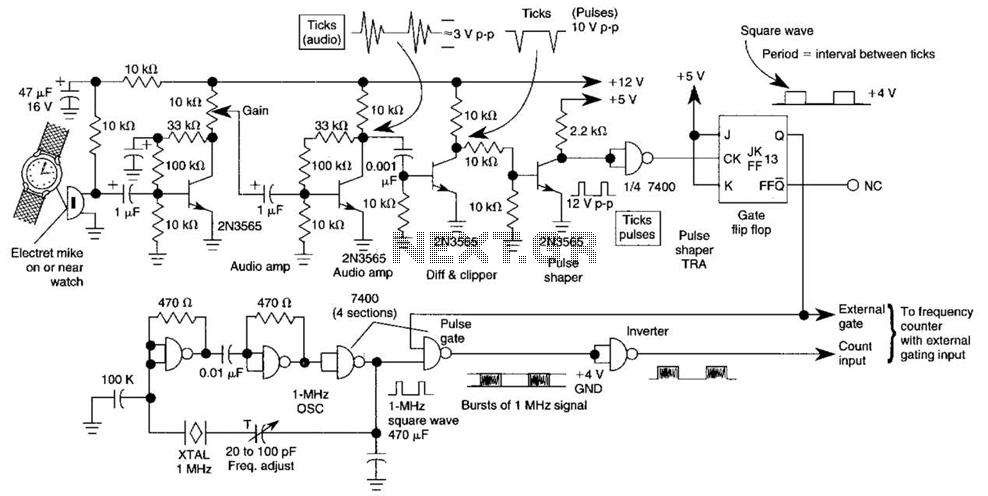
UM3561 high temperature detector circuit diagram
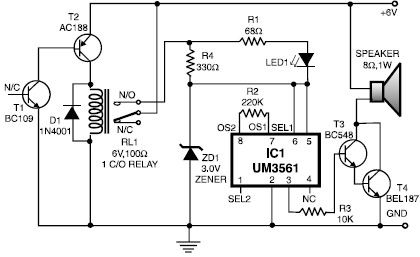
This heat detector alarm electronic project is designed using the UM3561 sound generator circuit along with several common electronic components. The heat detector circuit employs a complementary pair of transistors, consisting of an NPN and a PNP transistor, to sense heat. When the temperature near the T1 transistor rises, the resistance between the emitter and collector decreases, enabling current flow. Simultaneously, the T2 transistor also conducts since its base is connected to the collector of the T1 transistor. This activation energizes the RL1 relay, which in turn activates the siren, producing a fire engine alarm sound. The project requires a power supply of 6 volts DC, while the UM3561 integrated circuit is powered through a 3-volt zener diode, as the alarm sound necessitates a 3-volt DC power supply.
The heat detector alarm circuit operates on a principle of temperature sensing and sound generation, making it suitable for fire detection applications. The use of the UM3561 sound generator is central to producing the alarm sound, which mimics that of a fire engine, thus ensuring that it captures attention effectively.
The circuit's design incorporates a pair of transistors, T1 and T2, which work in tandem to detect changes in temperature. The T1 transistor acts as the primary sensor; when heat is detected, it transitions from a non-conductive to a conductive state, reducing the resistance between its emitter and collector. This change allows current to flow through T2, which is configured to respond to the output of T1.
The RL1 relay serves as an interface between the low-power transistor circuit and the high-power siren. When T2 is activated, it closes the relay contacts, allowing the siren to draw the necessary current from the power supply to operate effectively. The choice of a 6-volt DC supply ensures that both the relay and the siren receive adequate power for reliable operation.
For the UM3561 IC, the integration of a 3-volt zener diode is essential for stabilizing the voltage supplied to the sound generator. This configuration ensures that the sound output remains consistent, regardless of fluctuations in the power supply. The zener diode acts as a voltage regulator, thus protecting the UM3561 from over-voltage conditions that could damage the integrated circuit.
Overall, this heat detector alarm circuit is a practical solution for fire safety, combining simple electronic components with effective detection and alarm functionalities. Its design is straightforward, allowing for easy assembly and implementation in various settings, from residential to commercial environments.This heat detector alarm electronic project is designed using the UM3561 sound generator circuit and some other common electronic parts. This heat detector circuit project uses a complementary pair comprising npn and pnp transistor to detect heat.
When the temperature close to the T1 transistor is hot, the resistance to the emitter collector goes low and it starts conducting. In same time T2 transistor conducts, because its base is connected to the collector of T1 transistor and the RL1 relay energized and switches on the siren which produce a fire engine alarm sound. This electronic project must be powered from a 6 volts DC, but the UM3561 IC is powered using a 3 volt zener diode, because the alarm sound require a 3 volts dc power supply.
🔗 External reference
The heat detector alarm circuit operates on a principle of temperature sensing and sound generation, making it suitable for fire detection applications. The use of the UM3561 sound generator is central to producing the alarm sound, which mimics that of a fire engine, thus ensuring that it captures attention effectively.
The circuit's design incorporates a pair of transistors, T1 and T2, which work in tandem to detect changes in temperature. The T1 transistor acts as the primary sensor; when heat is detected, it transitions from a non-conductive to a conductive state, reducing the resistance between its emitter and collector. This change allows current to flow through T2, which is configured to respond to the output of T1.
The RL1 relay serves as an interface between the low-power transistor circuit and the high-power siren. When T2 is activated, it closes the relay contacts, allowing the siren to draw the necessary current from the power supply to operate effectively. The choice of a 6-volt DC supply ensures that both the relay and the siren receive adequate power for reliable operation.
For the UM3561 IC, the integration of a 3-volt zener diode is essential for stabilizing the voltage supplied to the sound generator. This configuration ensures that the sound output remains consistent, regardless of fluctuations in the power supply. The zener diode acts as a voltage regulator, thus protecting the UM3561 from over-voltage conditions that could damage the integrated circuit.
Overall, this heat detector alarm circuit is a practical solution for fire safety, combining simple electronic components with effective detection and alarm functionalities. Its design is straightforward, allowing for easy assembly and implementation in various settings, from residential to commercial environments.This heat detector alarm electronic project is designed using the UM3561 sound generator circuit and some other common electronic parts. This heat detector circuit project uses a complementary pair comprising npn and pnp transistor to detect heat.
When the temperature close to the T1 transistor is hot, the resistance to the emitter collector goes low and it starts conducting. In same time T2 transistor conducts, because its base is connected to the collector of T1 transistor and the RL1 relay energized and switches on the siren which produce a fire engine alarm sound. This electronic project must be powered from a 6 volts DC, but the UM3561 IC is powered using a 3 volt zener diode, because the alarm sound require a 3 volts dc power supply.
🔗 External reference
